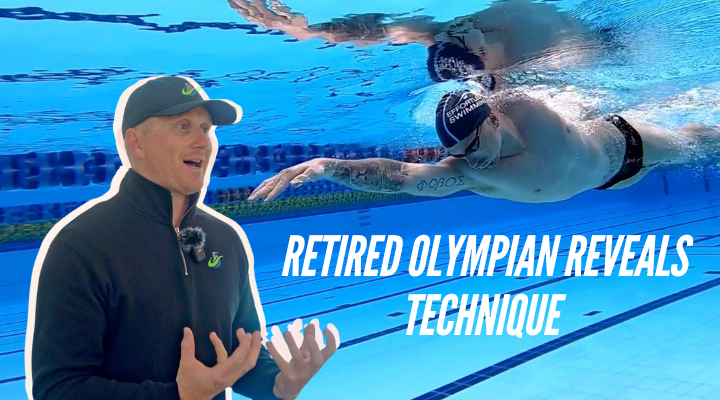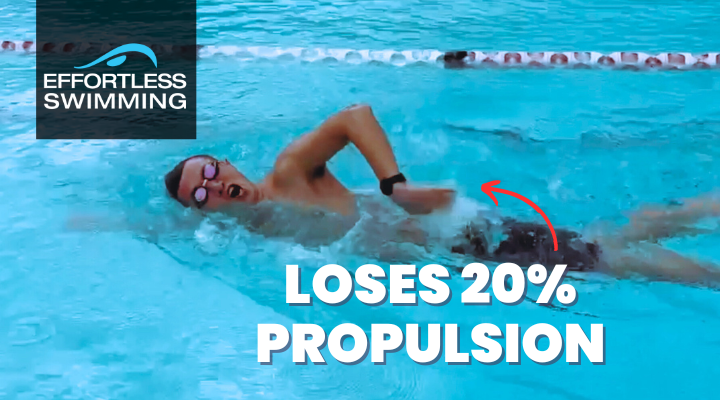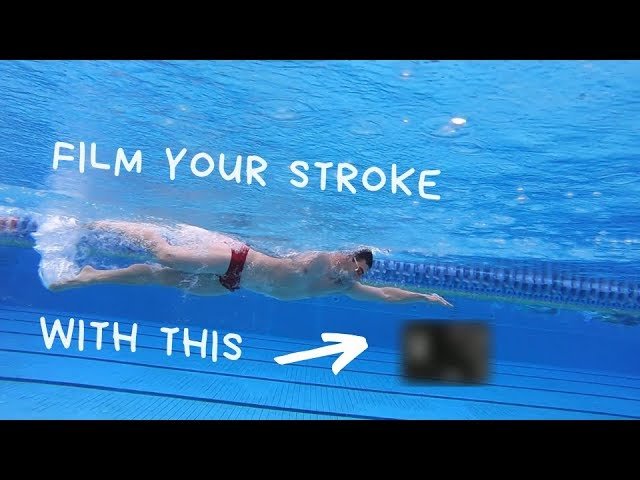Transcription:
The shoulder blade is protracted. It’s sort of forwards a bit so it’s not really into his lats. Hey, Brenton in from Effortless Swimming. In this episode of Feedback Friday we’re looking at a swimmer from the Netherlands who has sent in his videos for us to look at.
There’s a couple of things I want to focus on here, and I’m not going to go into everything. I just want to point out some of the main things that this swimmer can do to take his swimming to the next level. When I look over all here there’s a lot that this swimmer is doing well, and in these videos he’s swimming around a 126 pace per hundred. So depending upon what events he’s doing, then a 126 pace can be very good across a half distance, full distance Ironman. So what we’re looking at is how can he get faster and where can those improvements come from?
I think the majority of these improvements will come from increasing propulsion. I think there’s room to really be a lot more powerful in the stroke. We can minimize the drag in terms of body position and a few other things, but the majority of it’s going to come down to increasing propulsion. So let’s have a look at some of these things.
Under the water from here, if we look at body position, hips and heels are probably sitting a little bit low. Now there’s a number of things that do or that can cause it. I think two of those things are actually the kick and the style of the catch. With the kick, you’ll see he’s got a little bit of knee bend and the heels to break the surface on some of the kicks, but overall there is that bit of a drop through the legs.
Now one thing that will help him bring those legs up is I think actually bending the knees a bit more. On some of the kicks like through there and there, see how there’s very little knee bend. The knees are actually a bit too straight, and on a lot of videos, I talk about keeping the kick quite narrow. But like anything you can do that will go too far with it, so what I’d be looking to do there is just free up the legs a bit, allow a little bit more knee bend to come in. Because here what I’d want to be seeing is the heel up near the surface in this part of the stroke. So the glutes should be sort of starting that upwards kick, lifting this leg up higher, and allowing a bit more knee bend so he’d get this leg up a bit. And that’s going to minimize the drag quite a bit. That would be the first thing is just sort of freeing up the kick a little bit there by allowing a bit more knee bend. That’s one thing.
The other thing that I reckon will probably help with that is his front end of the stroke. The fingertips do stay a bit high through a lot of it. So you can see how the fingertips are higher than the elbow all the way until we get to there. I think that first part of the stroke there’s just a bit of that brake on position and the fingertips are pointing up, so you know that we want to get to that fingers below, wrist below elbow position pretty much straight away once that hand is entered. So the fingertip should always try and be the deepest part of the arm through this front end of the stroke, and you can sort of see it there as well with the fingers up. That’s just putting the brakes on it and sliding it down a bit, so that would be one thing to focus on.
Also, I think one of the other things that are probably causing the back half to drop is just on the breathing strokes, and I want to show you this position here. As he’s going to get the breath you’ll see that the right arm is just sort of … Two things are happening here. The right arm’s sort of drifting down so it’s dropping down, dropping down, and right here he’s probably not front quadrant. So at this stage, there’s nothing in front of his head. We always want to try and remain front quadrant, so always just a hand and arm out in front of the head there. So I think he’s probably just turning the shoulders a little bit too far which is causing this right arm to drop down, and he loses that front quadrant position. And that can often just cause the legs to drop because it just changes the balance of the body.
What you can do there is just try and reduce that shoulder rotation on the breathing stroke, keep the shoulders very tight up to about 45 degrees instead of what might be about 70 there. And that will allow you to keep the arm out front for longer for more balance, and overall that’s going to shift your balance and help keep the legs up.
Now the main thing I’d probably be looking to do here is just to increase the power and the strength through the stroke. Because if you’re swimming around that even 125 to 130 pace if you can sustain that across a half Ironman or full-distance Ironman, you’re going to be up there with some of the probably top 25% in the race. So for him to get down if that’s what he’s holding, to get down to 120 to 125 and beyond there, we’re going to have to look at increasing the power and propulsion.
One thing that I’d be looking to adjust here is the recovery. So our third core principle that we teach in our video membership is rock, return and align. And that return it talks about the return of the arm over the top. And part of that return we want to have an elbow led recovery which means that the elbow should stay in front of the hand for the first half of the recovery. Basically, the elbow should stay in front, in front, we don’t want this hand to pass the elbow before it gets to about here. You can see on some of these strokes that the hand … We call it a handled the recovery, and that gives you this closed position through the underarm. And we can’t really see the underarm at all there. As coaches, that’s one thing that we look for is if you got a good recovery, you’ll be able to see the underarm there. So you can say it’s more of a closed recovery because of that hand led recovery.
What we want to do here is basically just have the elbows move through a little bit more before the hands start swinging in front there. There’s a couple of drills you can do there. One that we like to use is watching a tip drag drill which you can see here. I think that can be a very good drill to do as long as you feel like the elbow’s leading the way through there.
Another drill which I find is very useful too is kick board press down drill, and this is one I got from Andy Jones. Kick board press down drill is a great drill just to keep you open through the chest and the shoulders with your recovery. Because if you’re rounded and you’re hunched over, not only does it impact your ability to have a strong posture and use the stronger muscles through the back and the shoulders, but it also makes it a lot harder to get the arm over the top in a nice and open way. That’s the one thing I’d be looking to change there, is work on, is that recovery. On a few strokes, it’s pretty good, but just overall it just needs a bit of an adjustment.
The other thing that will probably help with too is the entry. You can see here that the entry’s a bit flat as in the hand, and the elbow, and the entire arm kind of goes in together. Usually, we’ll see with the League swimmers the fingers will go first, the elbow will be slightly up, and we should see this sort of triangle shape which you can see here, this triangle shape as the hands about to go in. Then you can reach forward and straighten the arm in the water. You don’t want to enter flat because it just causes you to press down on the water, plus it does create quite a bit more turbulence and a bit more drag through that part of the stroke. But those two drills, the wide fingertip drag, the kick board press down drill, they both can help with that.
Then finally looking under the water … All right, here we go … Then looking under the water he actually gets to some pretty good positions through the catch, especially with the left arm here. This is getting to a pretty good position. You can see the lats are getting involved here too which is nice. So once he’s about here through to here, he’s looking pretty good with that left arm catch.
The right one, not too bad. If you look at this position. I don’t think he goes down deep enough with this right arm. He’s probably a little bit shallow with it. If you’re too shallow with your pull, you’re probably not getting into your lats. You’re probably not as strong as you could be. I’ll show you what it looks like from the front here. All right. On this right-hand side, you’ll see the right hand actually drifts out a bit wide. We usually want this right hand as it’s going through the catch just to be a little bit wider than the shoulder, not quite this wide.
As it continues on you’ll see that here the angle itself isn’t too bad, but I think he’s probably just … That’s the arm that’s pulling through a bit too soon. So you can actually see how this shoulder here is kind of … We’d call it the shoulder blade is protracted. It’s sort of forwards a bit so he’s not really into his lats. We just want to get those shoulders set back a bit more in this part of the stroke so he can really get the lats involved there. And again, that kick board press down drill can be a very good drill for it, or even just the power diamond drill that we like to use. That can be a great one just to adjust those shoulders and get a feel for what it’s like to get into the lats there. You’ll see on those strokes that he doesn’t breathe which we’ll get, I think, here. So breathe on all of them.
There are a few areas, he was up just up a bit too close to the surface which we’ll see in this one here. We want to sort of come under the body a bit more than that. You can see the shyness of the arm there and out that wide, it’s typically not as strong as if those hands are just a little bit wider than the shoulder, so we want to bring the arm just in slightly. Imagine just trying to pull yourself up. Much better if those hands are just that bit wider than the shoulders as opposed to out there.
If you’ve seen any of our videos before you’ll know that movements in swimming should be slow to fast. We want to be sort of slower at the front here and then accelerate through the pool, so start slow and then just pick it up. Not to the point to where you’re really rushing and slipping through there, but you just want to progressively build it up. And to me, it looks like it’s just a bit too slow all the way through. There’s not enough acceleration through the strokes so that’s where there’s an opportunity to basically get a lot more power, a lot more drive from each stroke there. It’s just sort of pick up the speed of the hand and has it almost volting him forwards with each stroke there. I’ll show you a video here just to sort of show it because there is room for it.
You can do a drill like catch and release drill. That can really help with hand speed. That’s where you’ve got these paddles and you’re swimming with paddles, just holding onto the top of them, but you actually let go of them underneath the water. You let go of them. The pressure of the water will keep them on the hand, and that’s a good run to just develop that speed of the hand there.
There are a few things this swimmer could look at doing, and continue to get to that next step with his swimming.
If you enjoyed these videos and you’re looking to work on your own stroke, then check out our video membership where we teach our five core principles of fast freestyle. That just gives you the roadmap for becoming a better swimmer, making things more efficient, and increasing your speed, and we also offer stroke analysis in that membership.
Thanks for watching. Make sure you Like and subscribe, and I’ll see you again next week.









